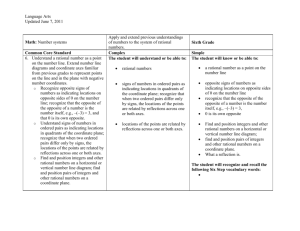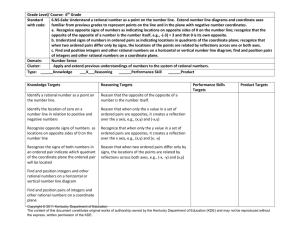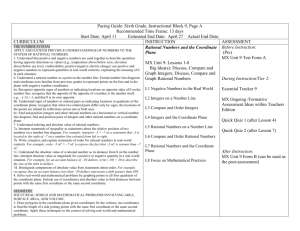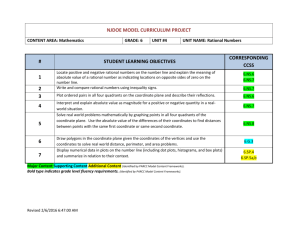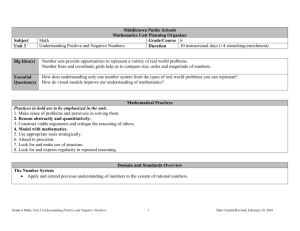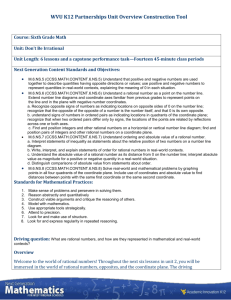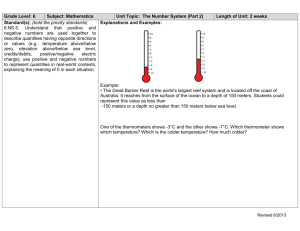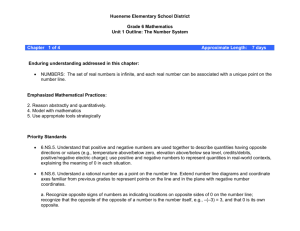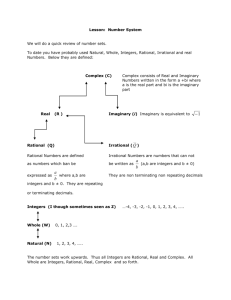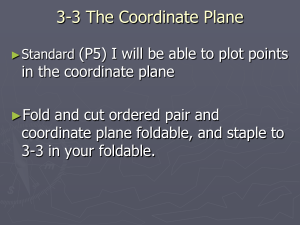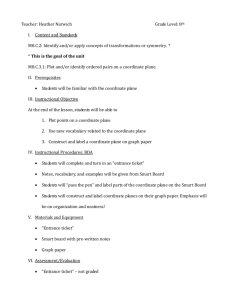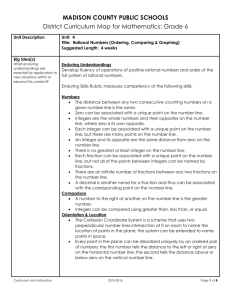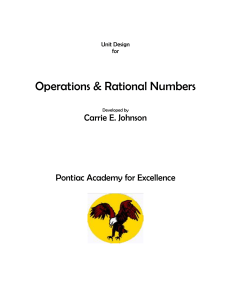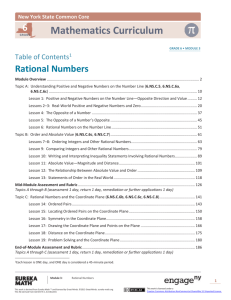6th Math Unit 4 - Livingston County School District
advertisement
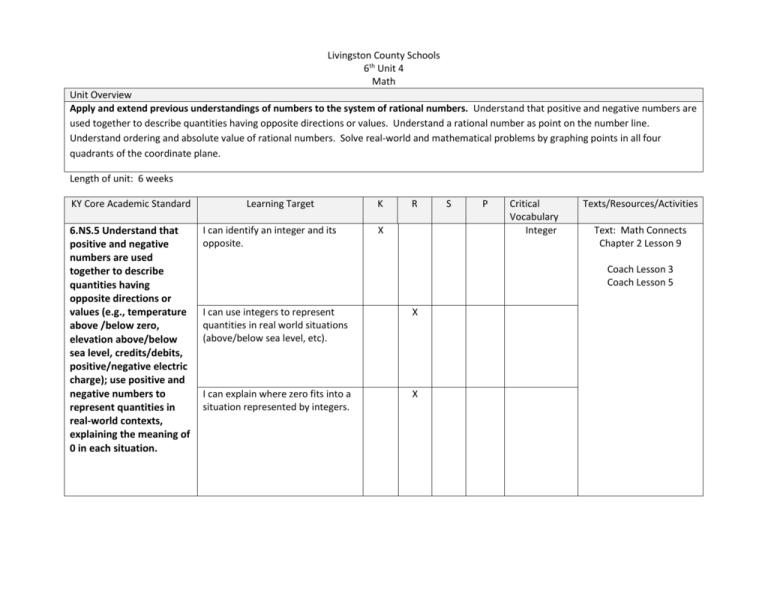
Livingston County Schools 6th Unit 4 Math Unit Overview Apply and extend previous understandings of numbers to the system of rational numbers. Understand that positive and negative numbers are used together to describe quantities having opposite directions or values. Understand a rational number as point on the number line. Understand ordering and absolute value of rational numbers. Solve real-world and mathematical problems by graphing points in all four quadrants of the coordinate plane. Length of unit: 6 weeks KY Core Academic Standard 6.NS.5 Understand that positive and negative numbers are used together to describe quantities having opposite directions or values (e.g., temperature above /below zero, elevation above/below sea level, credits/debits, positive/negative electric charge); use positive and negative numbers to represent quantities in real-world contexts, explaining the meaning of 0 in each situation. Learning Target I can identify an integer and its opposite. K R X S P Critical Vocabulary Integer Texts/Resources/Activities Text: Math Connects Chapter 2 Lesson 9 Coach Lesson 3 Coach Lesson 5 I can use integers to represent quantities in real world situations (above/below sea level, etc). X I can explain where zero fits into a situation represented by integers. X 6.NS.6abc Understand a rational number as a point on the number line. Extend number line diagrams and coordinate axes familiar from previous grades to represent points on the line and in the plane with negative number coordinates. a. Recognize opposite signs of numbers as indicating locations on opposite sides of 0 on the number line; recognize that the opposite of the opposite of a number is the number itself, e.g., -(-3) = 3 and that 0 is its own opposite. b. Understand signs of numbers in ordered pairs as indicating locations in quadrants of the coordinate plane; recognize that when two ordered pairs differ only by signs, the locations of the points are related by reflections across one or both axes. c. Find and position integers and other rational numbers on a horizontal or vertical number line diagram; find and position pairs of integers and other I can identify a rational number as a point on the number line. X Rational Number Point I can identify the location of zero on a number line in relation to positive and negative numbers . X I can recognize opposite signs of numbers as locations on opposite sides of 0 on the number line. X I can recognize the signs of both numbers in an ordered pair indicate which quadrant of the coordinate plane the ordered pair will be located. I can find and position integers and other rational numbers on a horizontal or vertical number line diagram. I can find and position pairs of integers and other rational numbers on a coordinate plane X Ordered Pair Quadrant X Integers Horizontal Vertical X Coordinate Plane Text: Math Connection Chapter 11 Lesson 1 Chapter 2 Lesson 9 Chapter 11 Lesson 7 Study Island 3F Study Island 3G I can reason that the opposite of the opposite of a number is the number itself. X I can reason that when only the x value in a set of ordered pairs are opposites, it creates a reflection over the y axis, e.g., (x,y) and (-x,y). I can recognize that when only the y value in a set of ordered pairs are opposites, it creates a reflection over the x axis, e.g., (x,y) and (x, -y). X X Reflection Coach Lesson 3 Coach Lesson 5 Coach Lesson 10 Coach Lesson 11 rational numbers on a coordinate plane. 6.NS.7abcd Understand ordering and absolute value of rational numbers. a. Interpret statements of inequality as statements about the relative position of two numbers on a number line diagram. For example, interpret -3>-7 as a statement that -3 is located to the right of -7 on a number line oriented from left to right. b. Write, interpret, and explain statements of order for rational numbers in real-world contexts. For example, write -3°C > -7°C to express the fact that 3°C is warmer than -7°C. c. Understand the absolute value of a rational number as its distance from 0 on the number line; interpret absolute value as magnitude for a positive or negative quantity in a real- I can reason that when two ordered pairs differ only by signs, the locations of the points are related by reflections across both axes, e.g., (-x, -y) and (x,y). I can order rational numbers on a number line. X X Text: Math Connects Chapter Study Island 3 H Study Island 3 G I can identify absolute value of rational numbers. X Absolute value I can interpret statements of inequality as statements about relative position of two numbers on a number line diagram. X I can write, interpret, and explain statements of order for rational numbers in real-world contexts. X Coach Lesson 4 Coach Lesson 6 Coach Lesson 11 world situation. For example, for an account balance of -30 dollars, write |-30| = 30 to describe the size of the debt in dollars. d. Distinguish comparisons of absolute value from statements about order. For example, recognize that an account balance less than -30 dollars represents a debt greater than 30 dollars. 6.NS.8 Solve real-world and mathematical problems by graphing points in all four quadrants of the coordinate plane. Include use of coordinates and absolute value to find distances between points with the same first coordinate or the same second coordinate. Spiraled Standards: I can interpret absolute value as magnitude for a positive or negative quantity in a real-world situation. X I can distinguish between comparisons of absolute value from statements about order and apply to real world contexts. X I can calculate absolute value. X Magnitude Text: Math Connects Study Island 3 G I can graph points in all four quadrants of the coordinate plane. X Coach Lesson 11 I can solve real-world problems by graphing points in all four quadrants of a coordinate plane. X I can calculate the distances between two points with the same first coordinate or the same second coordinate using absolute value when given only coordinates. X HOT Questions:
